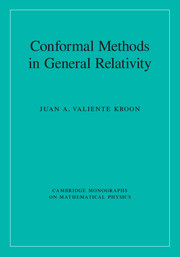Book contents
- Frontmatter
- Dedication
- Contents
- Preface
- Acknowledgements
- List of Symbols
- 1 Introduction
- Part I Geometric tools
- Part II General relativity and conformal geometry
- Part III Methods of the theory of partial differential equations
- Part IV Applications
- 15 De Sitter-like spacetimes
- 16 Minkowski-like spacetimes
- 17 Anti-de Sitter-like spacetimes
- 18 Characteristic problems for the conformal field equations
- 19 Static solutions
- 20 Spatial infinity
- 21 Perspectives
- References
- Index
18 - Characteristic problems for the conformal field equations
from Part IV - Applications
- Frontmatter
- Dedication
- Contents
- Preface
- Acknowledgements
- List of Symbols
- 1 Introduction
- Part I Geometric tools
- Part II General relativity and conformal geometry
- Part III Methods of the theory of partial differential equations
- Part IV Applications
- 15 De Sitter-like spacetimes
- 16 Minkowski-like spacetimes
- 17 Anti-de Sitter-like spacetimes
- 18 Characteristic problems for the conformal field equations
- 19 Static solutions
- 20 Spatial infinity
- 21 Perspectives
- References
- Index
Summary
This chapter discusses the basic theory of characteristic problems for the conformal field equations. Characteristic problems have been of great conceptual value in the development of the modern theory of gravitational radiation. Indeed, the seminal works by Bondi et al. (1962) and Sachs (1962b), in which the modern understanding of gravitational waves was established, were carried out in a setting based on a characteristic initial value problem; see also Sachs (1962c) and Newman and Penrose (1962). The connection between characteristic problems and the notion of asymptotic flatness, already present in the seminal work by Penrose (1963), was further elaborated in Penrose (1965, 1980). From a mathematical point of view, the realisation that the characteristic initial value problem for the Einstein field equations leads to a symmetric hyperbolic evolution system for which the machinery of the theory of partial differential equations (PDEs) is available was first established in Friedrich (1981b). In Friedrich (1981a, 1982) these ideas were subsequently extended to a situation in which part of the data is prescribed at null infinity –a so-called asymptotic characteristic initial value problem, the subject of this chapter. These results established the local existence of analytic solutions and were later extended to the smooth case by (1996b) using the method of reduction to a standard Cauchy problem by Rendall (1990); see Section 12.5.3.
There are two basic types of asymptotic characteristic problem for the conformal Einstein field equations. The first type is the so-called standard asymptotic characteristic problem – introduced in Friedrich (1981b) – where initial data are prescribed on null infinity and a null hypersurface intersecting null infinity in a two-dimensional surface with the topology of a 2-sphere; see Figure 18.1, left. In the second type – the so-called characteristic problem on a cone, first discussed in Friedrich (1986c) – one prescribes information on a null cone down to its vertex; see Figure 18.1, right. For reasons discussed in Section 12.5, characteristic problems on a cone are more technically involved. Existence results have been obtained in and Paetz (2013).
The standard and characteristic initial value problems have several structural properties in common. Moreover, the characteristic problem on a cone can be regarded as a limiting case of the standard characteristic problem.
- Type
- Chapter
- Information
- Conformal Methods in General Relativity , pp. 477 - 503Publisher: Cambridge University PressPrint publication year: 2016

